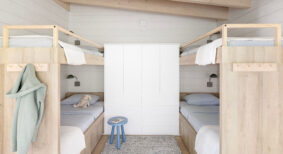District energy as a concept has existed since Roman times, when baths were heated from a centralized location and then transmitted to various buildings. However, in the past two or three decades the concept has gained new interest after being identified as a key measure towards helping cities to significantly reduce their greenhouse gas emissions.
Additionally, as buildings shift from doing less harm towards an ability to have a positive impact, and even regenerate the environment around it and those who inhabit it, district energy will play a crucial role in spanning that gap. As a result, numerous district energy systems are being built in existing and new urban areas, and this infrastructure now requires integration within the built environment. This creates an opportunity for designers to imagine district energy facilities not only as infrastructure that helps address climate change, but also as an urban intervention that enhances the experience of the public realm and creates a closer connection between energy and the community it powers. As we become more conscious of where energy comes from and how we use it, we have begun to question strategies for laying out infrastructure that had become regular practice in the 20th century.
In the past, energy had been mostly a rural and remote affair; where large, environmentally and economically expensive, centralized power plants were built unbeknown to most urban dwellers. At the other end, heating had been dealt with mostly at the building scale, where every structure had some form of combustion-based device or electric heater. As a benefit of better understanding the physics of different types of energy at varying scales, a new generation of infrastructure has emerged at the district scale. Simultaneously, the last 50 years have seen a resurgence in the importance of the neighbourhood as an essential building block in creating a strong community identity and sense of place within cities.
The vision of a livable urban environment now includes a more responsible attitude to its environmental impact locally and globally and a heightened awareness of the systems that support it – including energy. Integrated and effective systems, however, add an additional level of complexity to already intricate urban spaces, including the design, planning, and implementation of a district energy network.
In our experience, creating successful community energy projects requires research, feasibility analysis, phasing considerations, public engagement, facility design, and finally construction. Perhaps the most important of these is being able to capture the imagination of the community. For us, this is a unique urban design opportunity to provide physical connections with the infrastructure, incorporating elements of public art, establishing educational features and programmes, and by carefully considering the design of the facility itself and the public realm in which it will be sited.
Connections can be created by making the machinery visible to the public, either through large areas of glazing, port holes, or even safe cat walks over them. This provides a better understanding of the implications of sustaining our way of life, and at the same time displaying a commitment to better environmental performance of a neighbourhood or campus.
A different strategy to involve the community is to incorporate a public art element in the facility. This can be developed directly with artists from the neighbourhood and can manifest itself in exciting and often unexpected form: from artwork that figuratively represents the water that runs through a geoexchange system, to exhaust stacks taking the form of fingers and having lights that visualize the temperature of the system, and even an interactive musical instrument powered by residual steam from the district energy loop.
In designing the actual facility, the major decisions are around what shape it will take, how it relates to its surroundings, and in what way the details of the design enhance the story it is conveying. The flow of cars, bicycles, and pedestrians need to be rigorously studied, in particular in biomass plans, which rely on daily truck deliveries of fuel. The adjacency of what is around the facility will have a big impact on the design, such as whether it is in a very dense area, if there are single-family homes nearby, or if it is to be located within a park. All of these factors will then inform how it is integrated into the existing urban fabric.
As for the form itself, district energy plants can be designed by one of three approaches: landscape building, iconic object, or transparent box. The landscape building approach intends to blend the building in a subtle way, where it becomes part of the public realm. The iconic object goes in the opposite direction, where it celebrates its presence and takes a sculptural, highly visible form. The transparent box strategy opens up the insides of the plant and lets the machines become the most prominent feature.
Finally, the manner in which the building is detailed can add another layer to what it is communicating. This can take the form of utilizing green materials such as wood or sustainable features like a green roof, or to have overhangs and walkways that provide shelter for park users or a place for practicing Tai Chi and recharging our spiritual energy.
In addressing the major challenges that humanity faces today – including climate change, rapid urbanization and energy security – we are confident that districts, campuses, neighbourhoods and communities will be able to embrace the concept of community energy in new and creative ways that will help build a more resilient, healthy and positive relationship with our planet and our built environment and each other.
Martin Nielsen, Architect AIBC, MRAIC, P.Eng., LEEDAP, is principal in the Vancouver Dialog office. Esteban Matheus is an Intern Architect at the firm.






